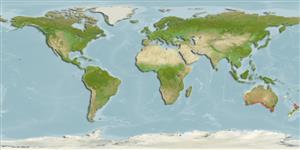>
Blenniiformes (Blennies) >
Blenniidae (Combtooth blennies) > Salariinae
Etymology: Parablennius: Greek, para = the side of + Greek, blennios = mucus (Ref. 45335).
More on author: Richardson.
Issue
Junior synonym Parablennius maoricus (Kner, 1864), is considered valid in Patzner et al., 2009:458.
Environment: milieu / climate zone / depth range / distribution range
पारिस्थितिकी
समुद्री; खारा बेनथोपिलाजिक. Temperate
Eastern Indian Ocean (Australia) to Southwest Pacific (New Zealand).
आकार / वज़न / Age
Maturity: Lm ? range ? - ? cm
Max length : 13.0 cm TL पुल्लिंग / अलिंग; (Ref. 9002)
Short description
पहचान कुंजी | आकृति विज्ञान | मौरफोमैटरिक्स
पृष्ठीय रीढ़ (सम्पूर्ण) : 12; पृष्ठीय सौफट रेज़ (सम्पूर्ण) : 16 - 19; गुदा कांटा: 2; ऐनल सौफट रेज़: 19 - 20. Dorsal fin with slight notch over posterior spines; caudal and pectoral fins rounded. Pale to ash-grey in color; young with moderate-sized dark blotches along sides; adults finely spotted (Ref. 9002).
Facultative air-breathing in the genus (Ref. 126274); Adults are found in rock pools and shallow estuaries, commonly under jetties along tops of pylons (Ref. 9002). Oviparous. Eggs are demersal and adhesive (Ref. 205), and are attached to the substrate via a filamentous, adhesive pad or pedestal (Ref. 94114). Larvae are planktonic, often found in shallow, coastal waters (Ref. 94114).
Life cycle and mating behavior
Maturities | पुनरुत्पत्ति | Spawnings | Egg(s) | Fecundities | लार्वा
Oviparous, distinct pairing (Ref. 205).
Kuiter, R.H., 1993. Coastal fishes of south-eastern Australia. University of Hawaii Press. Honolulu, Hawaii. 437 p. (Ref. 9002)
IUCN Red List Status (Ref. 130435)
Threat to humans
Harmless
Human uses
साधन
Special reports
Download XML
इंटरनेट स्रोत
Estimates based on models
Preferred temperature (Ref.
123201): 14.2 - 22.8, mean 17.8 °C (based on 394 cells).
Phylogenetic diversity index (Ref.
82804): PD
50 = 0.5000 [Uniqueness, from 0.5 = low to 2.0 = high].
Bayesian length-weight: a=0.00741 (0.00335 - 0.01640), b=3.02 (2.83 - 3.21), in cm total length, based on LWR estimates for this (Sub)family-body shape (Ref.
93245).
Trophic level (Ref.
69278): 2.8 ±0.1 se; based on size and trophs of closest relatives
लौटाव (Ref.
120179): ऊंचा, न्यूनतम जनसंख्या दुगनी समय अवलागत 15 महीने। (Preliminary K or Fecundity.).
Fishing Vulnerability (Ref.
59153): Low vulnerability (10 of 100).
Nutrients (Ref.
124155): Calcium = 78.9 [37.3, 158.6] mg/100g; Iron = 0.36 [0.21, 0.69] mg/100g; Protein = 17.5 [16.4, 18.5] %; Omega3 = 0.392 [0.166, 0.866] g/100g; Selenium = 7.97 [3.19, 19.57] μg/100g; VitaminA = 32.7 [9.2, 109.1] μg/100g; Zinc = 1.22 [0.81, 1.82] mg/100g (wet weight);
